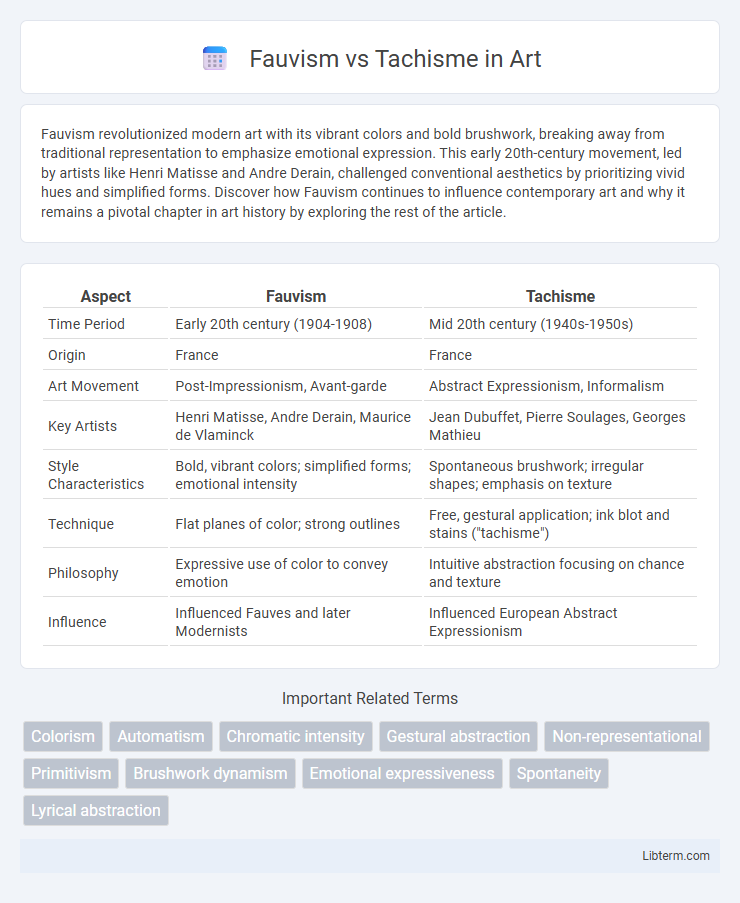Fauvism revolutionized modern art with its vibrant colors and bold brushwork, breaking away from traditional representation to emphasize emotional expression. This early 20th-century movement, led by artists like Henri Matisse and Andre Derain, challenged conventional aesthetics by prioritizing vivid hues and simplified forms. Discover how Fauvism continues to influence contemporary art and why it remains a pivotal chapter in art history by exploring the rest of the article.
Table of Comparison
| Aspect | Fauvism | Tachisme |
|---|---|---|
| Time Period | Early 20th century (1904-1908) | Mid 20th century (1940s-1950s) |
| Origin | France | France |
| Art Movement | Post-Impressionism, Avant-garde | Abstract Expressionism, Informalism |
| Key Artists | Henri Matisse, Andre Derain, Maurice de Vlaminck | Jean Dubuffet, Pierre Soulages, Georges Mathieu |
| Style Characteristics | Bold, vibrant colors; simplified forms; emotional intensity | Spontaneous brushwork; irregular shapes; emphasis on texture |
| Technique | Flat planes of color; strong outlines | Free, gestural application; ink blot and stains ("tachisme") |
| Philosophy | Expressive use of color to convey emotion | Intuitive abstraction focusing on chance and texture |
| Influence | Influenced Fauves and later Modernists | Influenced European Abstract Expressionism |
Introduction to Fauvism and Tachisme
Fauvism, emerging in the early 20th century, is characterized by bold, vibrant colors and simplified forms that emphasize emotional expression over realism. Tachisme, a post-World War II movement, centers on spontaneous brushwork, abstract shapes, and the use of color to convey raw emotion, often seen as a European counterpart to American Abstract Expressionism. Both movements broke from traditional representational art, prioritizing subjective experience and innovative technique.
Historical Contexts and Origins
Fauvism, emerging in the early 20th century around 1904-1908, originated in France as a radical break from traditional Impressionism, characterized by bold colors and simplified forms led by Henri Matisse and Andre Derain. Tachisme, developing in post-World War II Europe during the 1940s and 1950s, arose as part of the broader Abstract Expressionist movement, emphasizing spontaneous brushwork and abstract gestures, with key figures including Jean Dubuffet and Pierre Soulages. Both movements reflect pivotal shifts in modern art, Fauvism driven by Fauve artists' rebellion against academic norms, and Tachisme reacting to the trauma of war and existential themes through abstract expression.
Key Artists and Influencers
Key artists of Fauvism include Henri Matisse and Andre Derain, whose vivid use of color and bold brushwork defined the movement's aggressive departure from traditional representation. In contrast, Tachisme's key influencers such as Jean Dubuffet and Hans Hartung emphasized spontaneous, abstract expression through irregular dabs and strokes, reflecting the post-war European art scene. Both movements shaped modern art by challenging conventions, with Fauvism focusing on vibrant color and Tachisme on gestural abstraction.
Core Philosophies and Inspirations
Fauvism emphasizes bold, non-naturalistic colors and simplified forms inspired by the emotional impact of nature and primal expression, reflecting a break from representational art toward pure artistic freedom. Tachisme focuses on spontaneity, texture, and abstract forms born from the subconscious and the chaos of post-war existentialism, prioritizing the artist's instinctive gesture over deliberate composition. Both movements reject traditional realism but differ in Fauvism's vibrant, structured color planes versus Tachisme's fluid, uncontrolled application of paint.
Distinctive Techniques and Methods
Fauvism utilizes bold, vibrant colors and simplified forms with strong, expressive brushstrokes to evoke emotional responses, emphasizing flatness and abstraction. Tachisme emphasizes spontaneous, gestural application of paint, often using drips, blobs, and smears to convey raw emotion and texture, aligning with Abstract Expressionism. Fauvism's structured color planes contrast with Tachisme's fluid, dynamic surfaces, reflecting differing approaches to conveying intensity and movement.
Use of Color and Brushwork
Fauvism is characterized by bold, vibrant colors applied with flat, unmodulated brushstrokes that emphasize strong contrasts and simplified forms, reflecting emotional intensity and spontaneity. Tachisme employs a more fluid and expressive approach, with spontaneous, irregular brushwork that creates textured, abstract surfaces, often utilizing muted or earthy color palettes compared to the Fauves' bright hues. Both movements prioritize emotional expression through brushwork and color but diverge in Fauvism's structured vibrancy versus Tachisme's gestural abstraction.
Themes and Subject Matter Explored
Fauvism emphasizes bold, vibrant colors to depict landscapes, portraits, and scenes of everyday life, often focusing on emotional expression through intensified visual impact. Tachisme explores more abstract themes, favoring spontaneous brushwork and textured surfaces to convey inner emotions, existential angst, and subconscious states. Both movements depart from realism but differ in Fauvism's structured form and Tachisme's emphasis on automatism and gestural abstraction.
Critical Reception and Impact
Fauvism, emerging in the early 20th century, was initially met with shock and criticism due to its bold use of color and simplified forms but ultimately influenced modern art by paving the way for Expressionism and Abstract art. Tachisme, a post-World War II movement, received mixed reviews as it emphasized spontaneous brushwork and abstract forms, challenging traditional aesthetics while reinforcing the European contribution to Abstract Expressionism. Both movements significantly impacted the trajectory of modern art, with Fauvism shaping early avant-garde practices and Tachisme sustaining the dialogue around emotional expression and abstraction in mid-century art.
Comparison: Fauvism vs Tachisme
Fauvism, emerging in the early 20th century, emphasizes bold, vibrant colors and simplified forms to convey emotional intensity, characterized by artists like Henri Matisse and Andre Derain. Tachisme, a post-World War II movement, focuses on spontaneous brushwork and abstract expression, with key figures such as Jean Dubuffet and Pierre Soulages prioritizing texture and gestural marks over color harmony. The primary contrast between Fauvism and Tachisme lies in Fauvism's structured use of color to depict form versus Tachisme's embrace of abstraction and impromptu, tactile paint application.
Legacy and Influence on Modern Art
Fauvism pioneered bold color usage and emotional expression, directly influencing modern abstract art and movements like Expressionism and Color Field painting. Tachisme, known for its spontaneous brushwork and textural emphasis, laid groundwork for Abstract Expressionism and Informalism, shaping post-war European avant-garde trends. Both movements expanded artistic freedom, challenging traditional techniques and inspiring contemporary artists' exploration of form and color.
Fauvism Infographic

 libterm.com
libterm.com